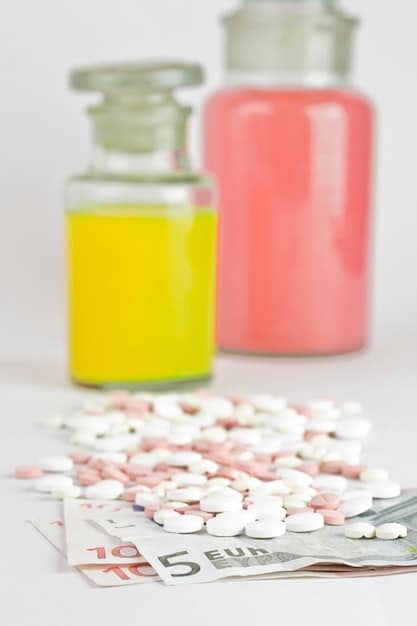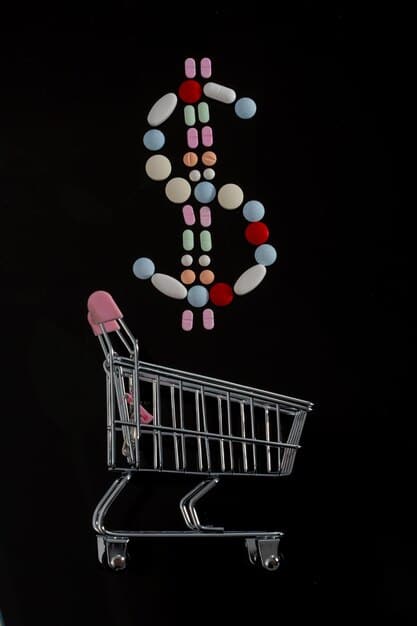Cut Rx Costs: Insider Tips for Saving on Prescription Drugs

Navigating the rising costs of prescription drugs requires strategic approaches, including exploring generic alternatives, utilizing prescription assistance programs, comparing prices across pharmacies, and discussing cost-saving options with your healthcare provider to ensure affordable access to necessary medications.
The escalating prices of prescription medications can significantly strain household budgets, leaving many Americans struggling to afford essential treatments. Learning how to navigate the rising costs of prescription drugs: insider tips for saving money on medications is crucial for maintaining health without breaking the bank.
Understanding the Factors Driving Up Prescription Drug Costs
Several elements contribute to the increasing expense of prescription drugs. By understanding these factors, consumers can better strategize ways to mitigate costs and make informed decisions about their healthcare spending.
The Role of Pharmaceutical Patents
Pharmaceutical patents grant drug companies exclusive rights to manufacture and sell a new medication for a set period, often 20 years from the date of filing. This exclusivity allows them to recoup research and development costs without competition from generic manufacturers.
During the patent period, drug companies typically set high prices to maximize profits, contributing to the rising costs of prescription drugs. Once the patent expires, generic versions can enter the market, often leading to significant price reductions.
The Impact of Marketing and Advertising
Pharmaceutical companies spend billions of dollars each year on marketing and advertising, targeting both healthcare professionals and consumers. These efforts can drive demand for newer, often more expensive, medications, even when older, equally effective alternatives are available.
- Direct-to-consumer advertising can lead patients to request specific drugs from their doctors, even if they are not the most cost-effective option.
- Marketing to healthcare professionals can influence prescribing habits, favoring newer drugs over generics.
- The costs associated with these marketing efforts are often passed on to consumers through higher drug prices.

In conclusion, understanding the factors driving up prescription drug costs, such as pharmaceutical patents and marketing expenses, can empower consumers to make informed decisions and seek out cost-saving strategies for their medication needs.
Exploring Generic Alternatives: A Cost-Effective Solution
Opting for generic medications is one of the most effective ways to reduce prescription drug costs. Understanding the equivalence of generics to brand-name drugs can help patients confidently switch to these more affordable options.
Generic drugs contain the same active ingredients, dosage form, strength, route of administration, and intended use as their brand-name counterparts. They are also required to meet the same rigorous standards for safety, quality, and efficacy by regulatory agencies.
How Generic Drugs Differ from Brand-Name Drugs
While generic drugs have the same active ingredients as brand-name drugs, they may differ in inactive ingredients, such as fillers, colors, and flavors. These differences do not affect the drug’s therapeutic effect but can influence its appearance.
Generic drugs are typically significantly cheaper than brand-name drugs because manufacturers do not have to repeat the extensive research and development required for market approval. This cost savings is passed on to consumers.
Discussing Generic Options with Your Doctor
It is crucial to discuss generic options with your healthcare provider to ensure they are appropriate for your specific medical condition. Your doctor can provide guidance on whether a generic alternative is available and suitable for your needs.
- Ask your doctor about generic alternatives during your appointment.
- Inquire about the safety and efficacy of generic drugs compared to brand-name drugs.
- Understand any potential differences in inactive ingredients and their implications.
Switching to generic medications can significantly reduce prescription drug costs without compromising the quality or effectiveness of your treatment. Open communication with your doctor is key to making informed decisions about your medication options.
Leveraging Prescription Assistance Programs (PAPs)
Prescription Assistance Programs (PAPs) offer financial aid to eligible individuals and families struggling to afford their medications. These programs are typically sponsored by pharmaceutical companies and nonprofit organizations.
PAPs can provide free or discounted medications to those who meet specific income and insurance criteria. Eligibility requirements vary depending on the program, but many consider factors such as household income, insurance coverage, and medical needs.
Navigating PAP Eligibility and Application
Applying for a PAP can be a complex process, but understanding the eligibility requirements and application steps can increase your chances of success. Research available programs and gather the necessary documentation before applying.
Many PAPs require proof of income, insurance coverage, and medical diagnosis. Some may also require a prescription from your doctor and a completed application form. Be sure to follow the instructions carefully and submit all required information.
Resources for Finding and Applying to PAPs
Several resources can help you find and apply to PAPs. Nonprofit organizations, government agencies, and online databases offer information on available programs and eligibility requirements.
- Pharmaceutical companies often have their own PAPs listed on their websites.
- Nonprofit organizations like the Patient Advocate Foundation and NeedyMeds provide comprehensive databases of PAPs.
- Government agencies such as the Health Resources and Services Administration (HRSA) offer resources on affordable healthcare options.

Leveraging Prescription Assistance Programs (PAPs) can provide significant financial relief for individuals struggling to afford their medications. By exploring available resources and understanding the application process, you can access the medications you need at a more affordable cost.
Comparing Prices Across Pharmacies: Shop Around for Savings
Prescription drug prices can vary significantly between pharmacies, even within the same geographic area. Taking the time to compare prices can lead to substantial savings on your medications.
Pharmacies set their own prices for prescription drugs based on factors such as acquisition costs, overhead expenses, and profit margins. These factors can vary widely, resulting in price differences that can impact your healthcare budget.
Online Pharmacies vs. Brick-and-Mortar Stores
Online pharmacies can sometimes offer lower prices than brick-and-mortar stores due to lower overhead costs. However, it is crucial to ensure that online pharmacies are licensed and legitimate to avoid counterfeit or unsafe medications.
Verify that online pharmacies are licensed by the National Association of Boards of Pharmacy (NABP) and require a valid prescription from your doctor. Be wary of websites that offer medications without a prescription or at prices that seem too good to be true.
Utilizing Price Comparison Websites and Apps
Several websites and apps allow you to compare prescription drug prices across different pharmacies. These tools can help you quickly identify the most affordable options in your area.
- GoodRx is a popular website and app that provides discounts, coupons, and price comparisons for prescription drugs.
- Blink Health allows you to pay for your prescriptions online and pick them up at a participating pharmacy.
- WellRx offers price comparisons, discount cards, and other cost-saving resources for prescription drugs.
Comparing prices across pharmacies is a simple yet effective way to save money on prescription drugs. By utilizing online tools and resources, you can shop around for the best deals and reduce your healthcare expenses.
Discussing Cost-Saving Options with Your Healthcare Provider
Open communication with your healthcare provider is essential for finding cost-saving options for your prescription medications. Your doctor can provide valuable guidance and recommendations based on your medical needs and financial circumstances.
Don’t hesitate to discuss your concerns about prescription drug costs with your doctor. They may be able to suggest alternative medications, adjust dosages, or recommend other cost-saving strategies.
Exploring Alternative Medications and Therapies
Your doctor may be able to prescribe alternative medications that are equally effective but more affordable. Generics, older drugs, or different formulations may provide the same therapeutic benefits at a lower cost.
In some cases, alternative therapies such as lifestyle changes, physical therapy, or complementary medicine may reduce or eliminate the need for prescription drugs. Discuss these options with your doctor to determine if they are appropriate for your condition.
Adjusting Dosages and Treatment Plans
Adjusting dosages or treatment plans can sometimes reduce prescription drug costs. Your doctor may be able to prescribe a lower dose or a less frequent dosing schedule without compromising your health.
- Ask your doctor if a lower dose of your medication is sufficient to manage your condition.
- Inquire about the possibility of taking medication less frequently or on an as-needed basis.
- Discuss whether you can switch to a maintenance medication with a lower cost.
Discussing cost-saving options with your healthcare provider is crucial for finding affordable solutions to your prescription drug needs. Open communication and collaboration with your doctor can help you manage your health without breaking the bank.
Utilizing Discount Cards and Coupons: Maximize Your Savings
Discount cards and coupons can provide significant savings on prescription drugs. These resources are often available for free and can be used at participating pharmacies to lower your out-of-pocket costs.
Discount cards and coupons work by negotiating lower prices with pharmacies on behalf of consumers. These savings are then passed on to you at the point of sale.
How Discount Cards and Coupons Work
Discount cards and coupons are typically free to obtain and can be used by anyone, regardless of insurance coverage. Simply present the card or coupon to the pharmacist when you fill your prescription to receive the discounted price.
Some discount cards and coupons offer fixed discounts on certain medications, while others provide savings based on a percentage of the retail price. Be sure to compare different cards and coupons to find the best deals for your specific prescriptions.
Where to Find Discount Cards and Coupons
Several websites, apps, and organizations offer discount cards and coupons for prescription drugs. Some of the most popular resources include:
- GoodRx offers discounts of up to 80% on prescription drugs at participating pharmacies.
- Blink Health allows you to pay for your prescriptions online and pick them up at a lower price.
- WellRx provides discount cards, coupons, and price comparisons for prescription medications.
Utilizing discount cards and coupons is a simple and effective way to maximize your savings on prescription drugs. By exploring available resources and comparing different offers, you can reduce your healthcare expenses and access the medications you need at a more affordable cost.
| Key Point | Brief Description |
|---|---|
| 💊 Generic Alternatives | Opt for generics with the same active ingredients. |
| 💰 Prescription Assistance | Utilize programs offering discounted or free meds. |
| 🛒 Pharmacy Price Checks | Compare prices at different pharmacies. |
| 👨⚕️ Doctor Consult | Discuss lower-cost alternatives with your doctor. |
Frequently Asked Questions
▼
High drug prices in the US are attributed to factors like pharmaceutical patents granting exclusivity, marketing expenses, and lack of government regulation on drug pricing.
▼
Yes, generic drugs contain the same active ingredients and meet the same quality standards as brand-name drugs, making them equally effective.
▼
Resources like the Patient Advocate Foundation and NeedyMeds offer databases of PAPs. Pharmaceutical companies also list their programs on their websites.
▼
Yes, many discount cards can be used regardless of insurance coverage. Compare the discounted price with your insurance co-pay to see which is cheaper.
▼
Ensure the online pharmacy is licensed by the NABP and requires a valid prescription. Be cautious of sites offering drugs without a prescription or at suspiciously low prices.
Conclusion
Navigating the rising costs of prescription drugs requires a multifaceted approach, combining strategies like exploring generic alternatives, leveraging prescription assistance programs, comparing pharmacy prices, and discussing cost-saving options with your healthcare provider to secure affordable access to essential medications.





